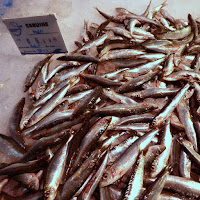First I have say it is not the same without Gerry and I only hope I can live up to her expectations (if only!). I'm giving it a go, anyway.
Montpellier is in the south of France:
⦁
sunshine and palm trees
⦁
bouillabaisse
⦁
vin table (cheap (ish) wines)
⦁
Van Gogh, Cezanne and the Fauves
⦁
beaches
⦁
Cannes and Cathar castles - like Carcassonne.
Specifically, welcome to Montpellier
⦁
sunshine on at least 300 days of the year, and palm trees
⦁
few foreign tourists (it attracts domestic tourists and is the place French people most want to live)
⦁
culture, parks, buzzing cafes and bars, music and dancing in the streets
⦁
young people (25% under 25), several universities, lots of students
⦁
extensive old town, minus walls, but mostly free of traffic
⦁
modern housing area near centre modelled on St Peter's in Rome, designed by Ricardo Bofill
⦁
medical school founded in 1220 and one of the biggest in France today
⦁
Jardin des Plantes - one of France's oldest botanical gardens, started as part of the School of Medicine
⦁
resting spot on the Camino de Santiago de Compostela
⦁
did I say sunshine already?
⦁
oh, and disappointing WiFi (I unreservedly now take this back, having found a couple of lovely cafes that have excellent 'wee-fee' for the cost of croissant and coffee).Can you see the coffee cup stains and crumbs? Yeah I know, Gerry would have had all this sorted, am I right, and it would be wine and beer stains.
So much to do and see - and all right here at my doorstep without needing to taking a single bus, train, tram or metro! Except there also great places to visit in the rest of the Languedoc-Rousillon region, and Provence is only an hour away on the train.
I'm staying in a first-floor apartment, in a quiet little street just two right turns from the main square (which is oval, and was full of police and demonstrators on May Day). There's a medieval Benedictine Church at one end of the street and the Musee Fabre (more soon) at the other.
The windows overlooking the street have these heavy wooden shutters that show how thick the walls of the ancient buildings actually are. The surprise in this apartment at no 16 is that on the other side, the floor-to-ceiling windows open onto an utterly charming garden courtyard (below) with an enormous lime tree, belonging to the facing ground floor apartment.
At the French-English conversion session at Le Bookshop I met Jean, who lives in the apartment exactly opposite me (too bad - with his wife). Just as I am spending time every day trying to learn French, he spends time learning English. His motivation is he wants to speak his dying words in English, "so my family will not understand what I am saying."

The apartment belongs to Nicholas. He is an Australian I met when we were both working at the National Library in Singapore in the 80s. He went on to have an amazing library career that included working as the National Librarian in Brunei, and then jobs at the Kew Gardens library, and the School of African & Oriental Studies in London. His last post was managing the Australian and NZ collections at the British Library. Like most of us, the constant brutalities of mismanaged restructures got him down, so he bought a little farm in the Lot region. He is gradually fixing up the old farmhouse and planting trees. But it is too cold to spend the winters there, and too isolated, so he has this apartment in Montpellier where he will live when he is too old to visit the farm. He has gone off to the countryside in Comiac and I'm staying in his lovely apartment.
OK, cooking my first meal in France on my own, here's a vegetable I have never had before - it's called endive. No problem, Nicholas has a copy of the useful 'Cuisine de tous les jours' which gives me a choice of recipes. Oh, they are in french. Pas probleme. Well, I don't think I'll be trying the other endive recipes in a hurry but my Endives au Gratin was passable.
Meanwhile the plate of smelly cheeses that Nicholas left has become stinky cheese extraordinaire and may set of the fire alarms if I can't finish it soon. The Camembert Rustique has already infected the yogurt with its wild spirit, while the milk and butter are trying to walk out of the frig in protest. Such a lovely cheese it is, too.























































